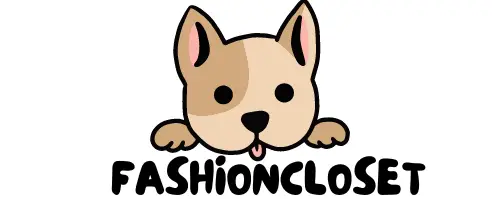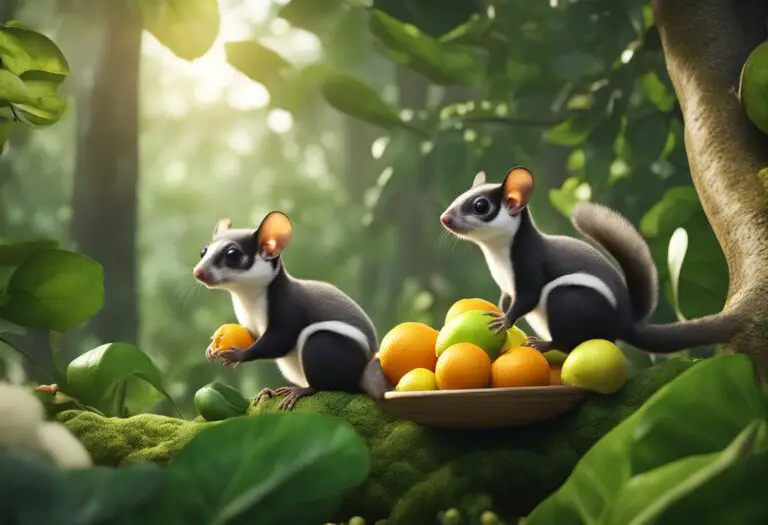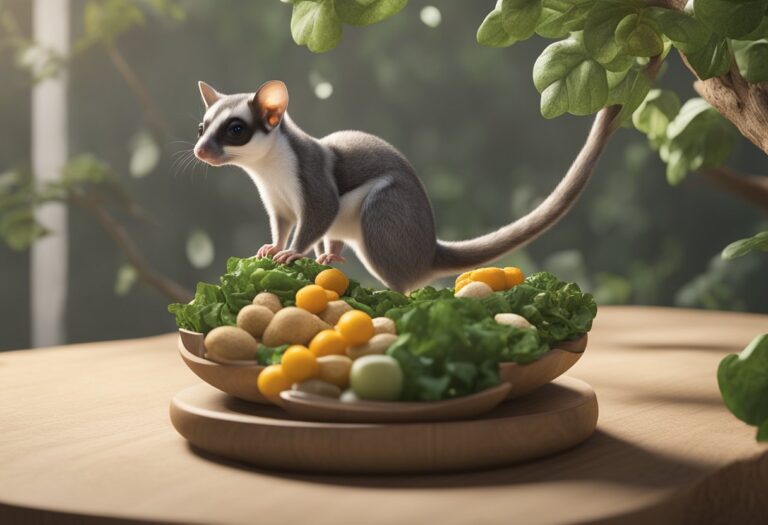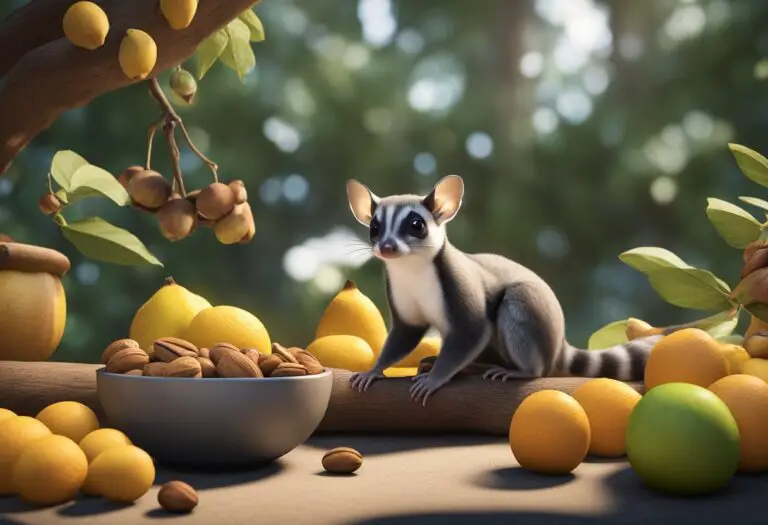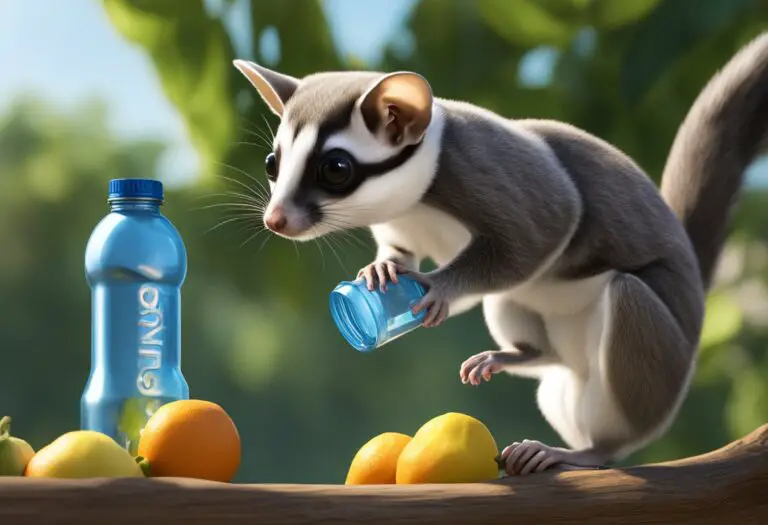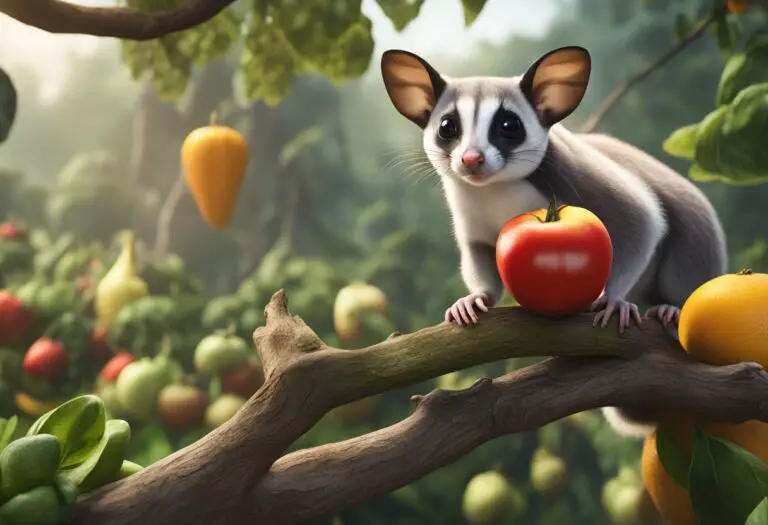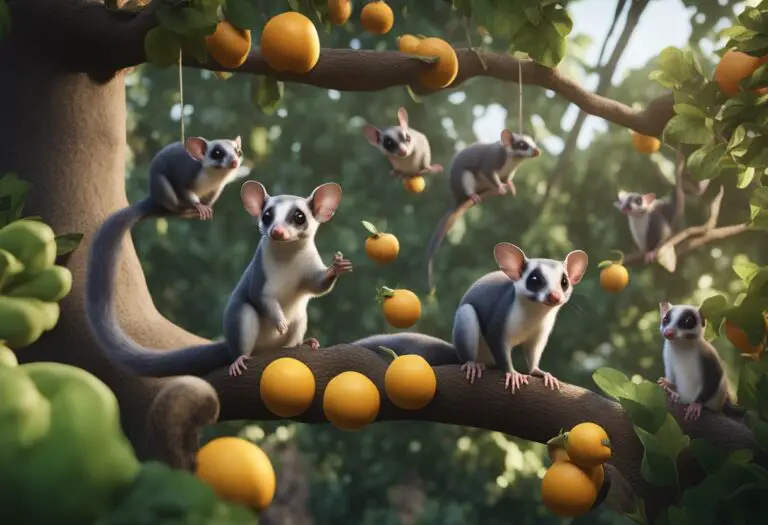Healthy Protein Sources for Sugar Gliders: A Must-Read
As a devoted sugar glider parent, you understand the importance of providing your furry friend with a balanced and nutritious diet. Protein, a crucial macronutrient, plays a vital role in supporting your sugar glider’s overall health and well-being. In this comprehensive guide, we’ll explore the best protein sources for sugar gliders, ensuring your beloved companion thrives with every bite.
Sugar gliders have unique nutritional requirements that set them apart from other pets. Unlocking the secrets to their optimal protein intake is the key to maintaining their vibrant energy and shiny coat. From insect protein like mealworms and crickets to commercial options like cat food and cooked eggs, we’ll dive deep into the world of sugar glider nutrition to empower you with the knowledge to make informed decisions about your furry friend’s diet.
Introduction to Sugar Gliders’ Dietary Needs
Sugar gliders, the captivating marsupial mammals, require a specialized diet to maintain their health and well-being. Understanding sugar gliders’ dietary needs and nutritional requirements is crucial for providing them with a balanced and nourishing diet. This section will explore the importance of a balanced diet for sugar gliders and delve into the unique nutritional needs that set them apart from other pets.
The Importance of a Balanced Diet
Ensuring a balanced diet is essential for sugar gliders, as they have specific nutritional requirements that differ from those of other animals. A well-rounded diet not only supports their overall health but also helps prevent nutritional deficiencies and related health issues. By understanding the importance of a balanced diet, caregivers can make informed decisions about the food choices they provide for their sugar gliders, ultimately contributing to their long-term well-being.
Understanding Sugar Gliders’ Unique Nutritional Requirements
Sugar gliders are unique in their dietary needs, and it is essential to recognize these nutritional requirements to ensure they receive the proper nourishment. Their diet should be carefully curated to cater to their specific nutritional needs, which may differ from those of other pets. By delving into the intricate details of sugar gliders’ dietary needs, caregivers can develop a comprehensive understanding of the optimal nutrition required to support their health and longevity.
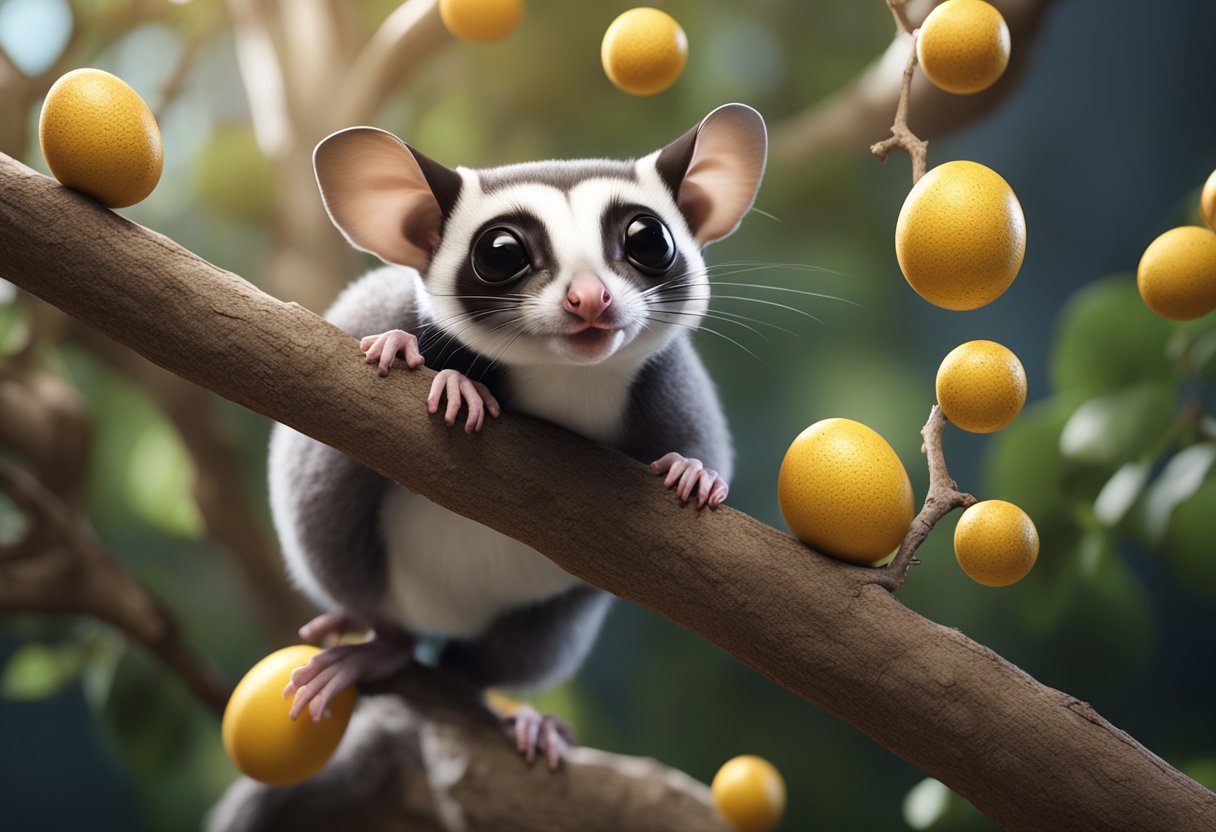
Protein Sources for Sugar Gliders
Protein is an essential macronutrient for sugar gliders, as it supports various bodily functions, including muscle development, immune system function, and overall growth. This section will provide an overview of the different protein sources for sugar gliders that can be incorporated into their diet, setting the stage for a more detailed exploration of specific options in the following sections.
Sugar gliders require a balanced diet that includes a variety of protein sources to meet their unique nutritional needs. From natural insect-based proteins to commercial products, there are several options to consider when providing your furry friend with the necessary protein intake.
| Protein Source | Benefits | Considerations |
|---|---|---|
| Insect Protein | Highly nutritious, resembles natural diet | Proper preparation and handling required |
| Commercial Protein Sources | Convenient, specialized formulas available | Careful selection to ensure quality and suitability |
| Cooked Eggs | Versatile, nutrient-dense | Proper cooking and storage methods needed |
By understanding the various protein sources for sugar gliders, you can make informed decisions about providing a balanced and nutritious diet for your furry companion. The following sections will dive deeper into the specific options, their benefits, and best practices for incorporating them into your sugar glider’s mealtime routine.
Insect Protein: A Natural Choice
Insects are a remarkably nutritious and natural protein source for sugar gliders. Offering a wide range of essential amino acids, minerals, and vitamins, insect-based proteins can play a vital role in supporting the overall health and well-being of these unique marsupials. Exploring the benefits of incorporating mealworms and crickets into a sugar glider’s diet can open up a world of culinary delights and optimal nutrition.
Mealworms: A Nutritious Treat
Mealworms, the larvae of the darkling beetle, are a highly digestible and nutrient-dense protein source for sugar gliders. These small, cylindrical-shaped insects are packed with high-quality insect protein, offering a balanced amino acid profile to support muscle development and tissue repair. Mealworms also contain essential vitamins and minerals, including vitamin B12, iron, and calcium, which are crucial for sugar gliders’ overall health and immune function.
Crickets: A Crunchy Delight
Another insect protein option that can be readily incorporated into a sugar glider’s diet is the humble cricket. Crickets are rich in insect protein and provide a crunchy, satisfying texture that many sugar gliders find irresistible. Beyond their protein content, crickets also offer a variety of other beneficial nutrients, such as omega-3 fatty acids, vitamin B12, and minerals like iron and calcium. Properly preparing and presenting crickets can make them a delightful and nutritious addition to your sugar glider’s feeding routine.
| Nutrient | Mealworms | Crickets |
|---|---|---|
| Protein | 20.1 g per 100 g | 20.6 g per 100 g |
| Fat | 13.8 g per 100 g | 5.5 g per 100 g |
| Carbohydrates | 5.7 g per 100 g | 3.1 g per 100 g |
| Calcium | 56 mg per 100 g | 35 mg per 100 g |
| Iron | 3.3 mg per 100 g | 3.1 mg per 100 g |
Commercial Protein Sources
In addition to natural insect-based protein sources, sugar gliders can also benefit from commercially available protein options. These products are designed to provide a balanced and complete protein source tailored to the specific nutritional needs of these unique marsupials.
Specialized Sugar Glider Pellets
Specialized sugar glider pellets are a convenient and nutritious commercial protein source for your furry friend. These pellets are formulated with high-quality protein, vitamins, and minerals to support the overall health and well-being of sugar gliders. When selecting sugar glider pellets, look for reputable brands that use clean, high-quality ingredients and have been specifically developed for sugar glider nutrition.
High-Quality Cat Food
Another commercial protein option for sugar gliders is high-quality cat food. Some species of cat food can serve as a supplemental protein source for sugar gliders, provided they are nutritionally balanced and do not contain any harmful ingredients. It is essential to choose a cat food that is free from artificial preservatives, colors, and additives, and one that is formulated for the specific life stage and dietary needs of your sugar glider.
When incorporating commercial protein sources into your sugar glider’s diet, it’s crucial to carefully read the labels, understand the nutritional profile, and introduce new products gradually. Monitoring your sugar glider’s response and adjusting the portions as needed will help ensure they receive a well-rounded and nourishing diet that supports their overall health and vitality.
Cooked Eggs: A Versatile Protein Option
When it comes to providing a balanced diet for your sugar glider, cooked eggs can be a fantastic source of protein. These nutrient-dense offerings offer a wealth of benefits for your furry friend’s overall health and well-being.
Eggs are an excellent source of high-quality protein, containing all the essential amino acids that sugar gliders require. They also contain a variety of essential vitamins and minerals, such as vitamin A, vitamin B12, selenium, and choline, which are crucial for maintaining a strong immune system and supporting healthy growth and development.
Preparing cooked eggs for your sugar glider is a straightforward process. Hard-boiled or scrambled eggs, without any added salt, butter, or other seasonings, are the safest and most suitable options. Be sure to allow the eggs to cool completely before serving them to your sugar glider, as they should be at a comfortable temperature for consumption.
Incorporating cooked eggs into your sugar glider’s diet can provide a versatile and nutritious protein option, helping to ensure your pet receives a well-balanced and complete nutritional profile. By carefully preparing and serving these animal-based protein sources, you can support your sugar glider’s overall health and well-being.
Incorporating Variety into Their Diet
Providing a varied diet is essential for maintaining the health and well-being of sugar gliders. By rotating different protein sources and combining various options, you can ensure your sugar glider receives a well-rounded and balanced intake of essential nutrients, helping to prevent nutritional deficiencies and keep your furry friend thriving.
Rotating Protein Sources
Regularly rotating the protein sources you offer your sugar glider is a key strategy for promoting a diverse and nutritious diet. This approach helps to expose your pet to a wider range of essential amino acids, vitamins, and minerals, reducing the risk of any nutrient imbalances. Consider introducing a variety of insect-based proteins, such as mealworms and crickets, along with commercial pellets and cooked eggs, to keep your sugar glider’s meals interesting and engaging.
Combining Different Protein Sources
Combining multiple protein sources within a single meal can also be beneficial for sugar gliders. By pairing different protein options, you can create a more complete and balanced nutrient profile, ensuring your sugar glider receives the optimal blend of essential nutrients. For example, you might offer a mix of mealworms, crickets, and a small serving of cooked egg to provide a diverse array of high-quality protein sources in one feeding.
Remember, maintaining variety in your sugar glider’s diet is key to supporting their overall health and well-being. By rotating protein sources and combining different options, you can help your furry friend thrive and avoid any potential nutritional deficiencies.
Handling and Storing Protein Sources
Maintaining the safety and quality of the protein sources you provide for your sugar glider is crucial. Proper handling and storage techniques are essential to ensure your furry friend receives the optimal nutrition they need. Let’s explore the best practices for handling protein sources and storing protein sources effectively.
Proper Storage Techniques
Different protein sources require specific storage methods to preserve their freshness and nutritional value. For insect protein sources, such as mealworms and crickets, it’s essential to store them in a cool, dry environment, preferably in the refrigerator or freezer. This helps prevent the growth of bacteria and keeps the insects fresh for longer.
When it comes to commercial protein sources, like specialized sugar glider pellets and high-quality cat food, it’s important to follow the manufacturer’s storage instructions. These products are typically shelf-stable, but proper storage in a cool, dry place can help maintain their quality and prevent spoilage.
For cooked eggs, a versatile protein option, store them in an airtight container in the refrigerator. Maintain proper food safety by consuming the cooked eggs within a few days to ensure they remain safe for your sugar glider to enjoy.
Food Safety Considerations
Ensuring food safety is crucial when handling and preparing protein sources for your sugar glider. Always practice good hygiene by thoroughly washing your hands and the preparation area before and after handling any protein-rich foods.
When it comes to insects, take care to source them from reputable suppliers and inspect them for any signs of contamination or spoilage. Avoid feeding your sugar glider any insects that appear unhealthy or have been exposed to potential contaminants.
For commercial protein sources and cooked eggs, carefully follow the storage and expiration guidelines to ensure they are fresh and safe for consumption. Discard any protein-rich items that have exceeded their recommended shelf life or show signs of spoilage.
| Protein Source | Proper Storage | Food Safety Considerations |
|---|---|---|
| Insects (Mealworms, Crickets) | Refrigerate or freeze to maintain freshness | Source from reputable suppliers, inspect for contamination |
| Commercial Protein (Pellets, Cat Food) | Follow manufacturer’s storage instructions, keep in a cool, dry place | Adhere to expiration dates, discard any spoiled items |
| Cooked Eggs | Store in an airtight container in the refrigerator | Consume within a few days, maintain proper food hygiene |
By following these guidelines for handling protein sources and storing protein sources, you can ensure the safety and quality of the protein-rich foods you provide to your sugar glider, supporting their overall health and well-being.
Signs of Protein Deficiency
Monitoring your sugar glider’s health closely is crucial to identifying any signs of protein deficiency. Some common symptoms may include weight loss, muscle wasting, poor coat condition, and lethargy. If your sugar glider appears to be losing weight or lacks the energy they once had, it could be an indication that their protein intake is inadequate.
Monitoring Their Health
Regularly weighing your sugar glider and observing their behavior can help you detect any changes that may signal a protein deficiency. Additionally, paying attention to their coat and overall physical condition can provide valuable clues about their nutritional status. If you notice any concerning changes, it’s essential to take action promptly to address the issue.
Consulting a Veterinarian
If you suspect your sugar glider may be experiencing a protein deficiency, it’s highly recommended to consult a veterinarian. They can perform a comprehensive examination, conduct any necessary tests, and provide personalized guidance on adjusting your sugar glider’s diet to ensure they receive the appropriate amount of protein and other essential nutrients. By working closely with a professional, you can ensure your sugar glider’s health and well-being remain a top priority.
